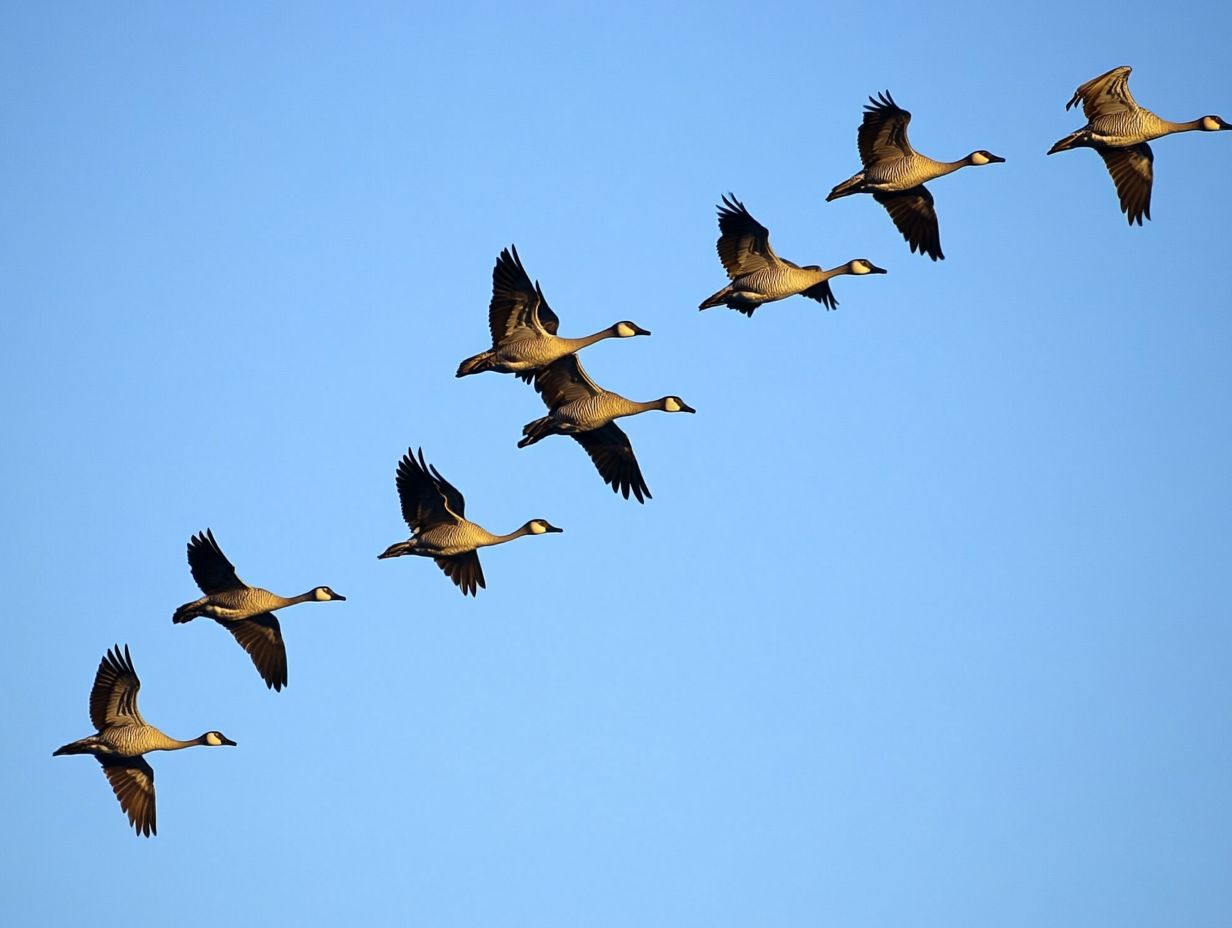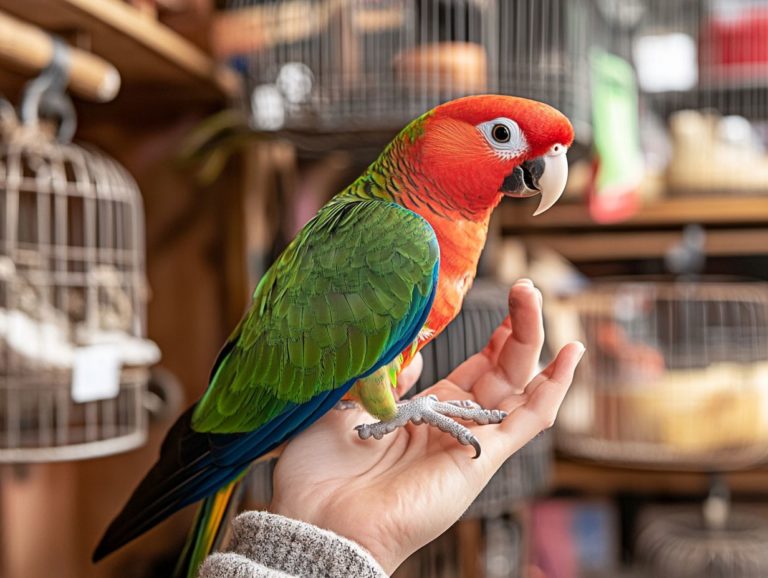Understanding Bird Hierarchy in Flocks
Birds navigate complex social structures. These hierarchies are vital for their survival and social interactions.
From the strong pecking order found in linear hierarchies to the more flexible communal structures, each type offers distinct advantages and challenges.
Discover why birds establish ranks and how these hierarchies transform their lives. This exploration delves into the reasons birds form these structures and their benefits to the flock.
Join us in exploring the captivating world of avian social dynamics and uncover how these structures shape their lives.
Contents
Key Takeaways:

- Understanding bird hierarchy is crucial for comprehending their behavior and interactions within flocks.
- There are three main types of bird hierarchy: linear, despotic, and communal, each with its own characteristics and advantages.
- Hierarchy is established through factors like age, size, and behavior, playing a significant role in resource allocation and group cohesion.
The Importance of Hierarchy in Bird Flocks
Why hierarchy matters in bird flocks goes far beyond simple social interactions. It holds a vital place in their communities, impacting everything from resource allocation to predator avoidance.
Whether in the wetlands of Budapest or the skies over North Carolina, grasping how these hierarchies function reveals the intricate relationships among species like shorebirds, honeybees, and ants.
By examining behavioral observations, you can witness how dominant and subordinate birds navigate their social structures, ensuring efficient foraging flights while maintaining cohesion within their flock.
Why Birds Form Hierarchies
Birds establish hierarchies to maintain social order and streamline collective decision-making within their flocks. This social structure, often referred to as a pecking order, plays a crucial role in reducing conflicts while enhancing survival through cooperation during critical tasks like foraging and nesting.
Take emperor penguins, for example. Their clear hierarchy allows individuals to conserve energy during the harsh Antarctic winters by organizing their huddles more efficiently.
Similarly, in Blue Tits, dominant birds often claim the best feeding spots. This not only benefits them but also creates a structured system that helps younger or less dominant birds learn optimal foraging techniques.
Such behaviors illustrate how hierarchies significantly influence interaction patterns, communication, and learning within avian communities, enabling these species to thrive in varied environments.
Types of Bird Hierarchy
Bird hierarchies can be classified into three distinct types: linear hierarchy, despotic hierarchy, and communal hierarchy. Each of these categories possesses unique characteristics that significantly influence the structure and dynamics of flocks.
Linear Hierarchy
In a linear hierarchy, you ll find birds arranged in a clear order of dominance, where each individual holds a distinct rank and relationship with others this is the essence of their pecking order.
This structured arrangement is crucial for maintaining flock cohesion and significantly impacts individual behaviors across various bird species.
Take a group of Magpies, for example. Here, individuals often showcase dominance behaviors by asserting their rank through vocalizations, posturing, or even aggressive interactions.
These actions not only uphold the hierarchy but also help minimize conflicts; lower-ranking members grasp their position and adapt their behavior accordingly.
The outcome is a more stable social environment, allowing individuals to thrive. With a clear understanding of their place within the flock, they reduce misunderstandings and foster collaboration during essential activities like foraging or nesting.
Despotic Hierarchy

In a despotic hierarchy, one or a few dominant birds control the flock. This can lead to aggressive behavior and unequal resource distribution.
For example, European starlings at the top of the social ladder defend their feeding areas fiercely. This can push subordinate birds to less favorable spots.
Such dynamics can create conflict and hinder cooperation within the group, ultimately affecting survival rates.
In the case of African grey parrots, observed hierarchies reveal how decision-making favors dominant individuals, limiting the flock’s ability to thrive.
Communal Hierarchy
A communal hierarchy creates a more egalitarian structure among birds, fostering breeding together and shared responsibilities within the flock.
This arrangement enhances social order, with individuals stepping into specific roles that benefit the entire community. For instance, in honeybee colonies, worker bees take on various tasks like foraging, nursing, and defending the hive, ensuring the colony s survival.
Similarly, shorebirds engage in cooperative behaviors, with some keeping watch while others feed. This maximizes foraging success and minimizes predation risks.
These examples clearly demonstrate how structured interactions provide survival advantages and promote collective well-being, highlighting how a communal hierarchy can enhance social cohesion within animal groups.
How Hierarchy is Established
The hierarchy within bird flocks is shaped by a multitude of factors. Individual behaviors, environmental influences, and intricate social interactions across various species all play crucial roles in establishing this pecking order in birds.
Factors that Determine Rank
Rank within bird hierarchies is shaped by a fascinating blend of dominance behaviors, age, and gender dynamics, creating intricate social interactions.
Take a flock of chickens, for example. The pecking order clearly illustrates how these elements interact; older hens typically occupy higher ranks due to their experience.
In a parrot community, vocalization patterns signal social standing. The most dominant birds often use loud, assertive calls to assert their presence.
Some species, like the African grey parrot, showcase their intelligence through social play, highlighting that rank involves both aggression and cognitive abilities.
These fascinating dynamics show the complex social lives of birds, inviting you to appreciate the depth of their interactions.
Benefits of Bird Hierarchy
Bird hierarchies offer significant advantages that enhance survival. They improve efficient resource allocation and promote stronger group cohesion.
Efficient Resource Allocation

Efficient resource allocation is a primary advantage of a hierarchy within bird flocks, as it streamlines access to feeding grounds and nesting rights.
This structured system allows dominant individuals to establish territories and regulate feeding times, minimizing competition and alleviating stress among flock members. For instance, African grey parrots often secure priority access to the best foraging spots, ensuring adequate nutrition.
You can also see the benefits of the predictability a structured hierarchy provides, leading to harmonious interactions. This social order encourages cooperative behaviors, like sentinel duties, where lower-ranking birds serve as lookouts. This enhances the survival of the entire flock and ensures resources are utilized efficiently.
Improved Group Cohesion
Improved group cohesion, shaped by established hierarchies, significantly enhances the overall functionality and survival of bird flocks during foraging and predator avoidance.
In these social structures, dominant individuals often step into leadership roles, promoting organized movement and minimizing chaos. This leadership fosters synchronized behaviors, enabling the group to adapt seamlessly to changing environments.
Complex communication signals, including vocalizations and body movements, play a pivotal role in maintaining these relationships, ensuring that all members stay aligned in their actions. These behavioral patterns not only streamline collective flying but also cultivate unity, allowing the flock to respond swiftly to potential threats.
As a result, the interplay of hierarchy and communication is crucial, profoundly increasing the flock’s chances of survival.
Challenges and Conflicts within Hierarchy
While hierarchies offer significant advantages to bird flocks, they also bring forth challenges and conflicts, especially manifested as aggression and displays of dominance among the birds.
Aggression and Dominance
Aggression and dominance behaviors play a crucial role in maintaining social order within bird flocks. They often appear as assertive displays that reinforce the pecking order.
These interactions are essential for determining access to resources like food and nesting sites and for establishing mating rights among the birds. Take chickens, for instance; dominant birds assert their control through pecking, skillfully navigating the intricacies of their social structure.
Similarly, in wolf packs, aggressive behaviors are vital for maintaining hierarchy. The alpha male and female showcase their dominance through posture and vocalizations. Such displays are not merely for show; they ensure social cohesion and stability, ultimately influencing survival and reproductive success within the group.
Strategies for Maintaining Hierarchy
Birds utilize a variety of strategies to uphold their hierarchies, incorporating both behavioral observations and tactics that reinforce their ranks.
These strategies reveal fascinating insights into bird behavior! For example, cooperative breeding not only boosts the survival of their young but also strengthens the bonds among adult members, creating a supportive network that is vital for maintaining hierarchy.
Displays of aggression clearly signal dominance, enabling individuals to assert their positions without resorting to physical confrontations. Communication signals, including distinct calls and body language, are essential in preserving order and facilitating interactions across different ranks, ultimately contributing to the stability of their social structures.
Frequently Asked Questions

What is bird hierarchy in flocks?
Bird hierarchy in flocks refers to the social structure and ranking system within a group of birds. It determines dominance and submission among individuals and plays an important role in the group’s behavior and dynamics.
How is bird hierarchy established?
Bird hierarchy is established through various forms of communication, such as vocalizations, displays of aggression or submission, and physical interactions. These interactions help determine the dominant birds and their rank in the hierarchy.
Do all bird flocks have a hierarchy?
Yes, most bird flocks have a hierarchy, although the level of dominance and complexity varies among species. Some birds, such as chickens and peafowl, have highly structured hierarchies, while others have more fluid and flexible systems.
What are the benefits of having a bird hierarchy in flocks?
Hierarchy in flocks helps maintain order and reduce conflict among the birds. Dominant birds have access to resources, such as food and mates, while submissive birds may receive protection and support from the dominant members. This allows the group to function efficiently and increases their chances of survival.
Summary: Bird flocks operate within complex hierarchies that enhance their survival through organized behavior and effective communication. For a deeper insight into this fascinating topic, understanding the social structure of birds reveals both the benefits and challenges that require continuous negotiation among the birds.
Can Bird Hierarchy Change Over Time?
Yes, bird hierarchy changes over time! Factors like age, experience, and physical abilities play a big role.
A dominant bird might lose its rank to a younger or stronger individual. Conversely, a submissive bird can rise if it proves valuable to the group.
How Understanding Bird Hierarchy Benefits Watchers and Researchers
Understanding bird hierarchy helps us predict flock behavior and individual interactions. It also sheds light on how environmental changes affect bird populations and their social structures!






